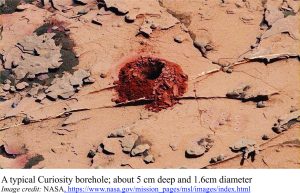Organic compounds (i.e. molecules that contain carbon bonded to hydrogen) are not the prerogative of earth. They have been identified (remotely) in interstellar space, stellar gas clouds, and measured directly on comets and meteorites. And now Mars.
We tend to associate earth-bound organic compounds with life forms and processes, past and present. So, any discovery of organics elsewhere – the solar system and beyond – always begs the question; were these too associated in some way with extra-terrestrial life? The answer is usually ‘No’, although media outlets, frequently prone to exaggeration, tend to stretch the answer beyond credulity. In fact we know that most of the organic molecules identified in deep space and on comets probably had an abiotic-non-biological origin.

One of the technical hurdles when working with Martian or comet samples, is the analysis of small volumes of rock and soil, that might, if we’re lucky, contain organic compounds in even smaller amounts. Curiosity Rover has, among its sophisticated array of instruments, a small electrically heated furnace that basically cooks the samples. The method, called analytical pyrolysis, is used to identify complex organic compounds of unknown composition. Samples are placed in the furnace and heated gradually through temperatures up to 900oC. As temperature increases, small molecular fragments are thermally severed, or broken from the unknown compound. Heating is usually done in an inert atmosphere (like Helium), that acts as a carrier for the smaller fragments, so they can be identified by gas chromatogram. The molecular fragments, once identified, help to fingerprint the unknown organic compound.
Two back-to-back papers in the June 2018 issue of Science, provide grist for the ‘Life on Mars’ mill. The new data do not show definitively that there was/is Martian life, but it does point to some intriguing possibilities.
Soil samples collected by Curiosity Rover from an ancient lake bed in Gale Crater (3 billion years old) are responsible for the current burst of extra-terrestrial excitement. The samples were heated incrementally to 860oC, releasing a range of organic fragments including aromatic organic compounds containing benzene rings (hexagon-shaped molecules), and sulphur-bearing molecular fragments belonging to chemical groups called thiols and thiophenes.

These discoveries are exciting in themselves, but they do not point definitively to any particular origin – whether biological, geological, or derived from meteorites. One reason for this ambiguity is the potential for organic molecules to be altered over time. Note that the Martian organics have been sitting around for about 3000 million years. Organic molecules are susceptible to chemical change if they come into contact with groundwater, hydrothermal-geothermal fluids (fluids at elevated temperatures), and importantly, ionizing solar radiation that on Mars’ surface is intense because of the thin atmosphere (compare this to the strong filtering attributes of earth’s atmosphere). In fact, the sulphur-bearing compounds are thought to be alteration products that may have enhanced the overall preservation of Martian organic matter. The current analyses show that complex organic molecules do exist on Mars, although they were not able to identify any clear biological signals. Buried organic matter, that is shielded from ionizing radiation, may offer the best opportunity to identify fossil biological molecules
Our current preoccupation with methane is linked to its important role as a greenhouse gas. Methane, like other organic compounds on earth, is largely a by-product of biological processes. It’s only natural then, to entertain the idea that methane in the Martian atmosphere might also be linked to past life forms. Such flights of scientific imagination are brought to an abrupt halt, when we are reminded that methane can also be produced by geological processes, such as the chemical alteration of certain igneous rocks, or from melting clathrates – indeed, subsea methane bursts are well documented in polar regions.
The amount of methane in the Martian atmosphere is really tiny – measured in parts per billion. The concentration is also known to vary over time and geographically, but until Curiosity rover began its adventures in 2012, the data was too sparse to identify any kind of regularity or pattern of variation. Regular atmospheric gas measurements by Curiosity over the last 3 years, have begun to fill this data gap.
The gas measurements were taken during Curiosity’s residence in Gale Crater, where there is a strong signal of seasonal variation, from 0.24 to 0.65 parts per billion methane by volume (yes, the amounts are tiny). The magnitude of the variation is larger than that expected from ultra violet light degradation of organic compounds delivered by meteorites, or the expected seasonal changes in atmospheric pressures. The authors conclude that the variation is caused by seasonal changes in methane released from local reservoirs at or buried beneath the Martian surface. One intriguing possibility is methane release from clathrates, analogous to those commonly found at shallow depths beneath earthly sea floors (a clathrate is water ice that contains weakly bound methane molecules). Surface heating during the Martian summer would lead to increased methane release through permeable soils, or via open fractures and faults.
As so often happens in science, the new data provoke more questions about the nature of the original organic matter, than providing definitive answers. But this is a positive outcome. We now know there are diverse, complex organic compounds preserved in Martian mudrocks like those deposited in ancient lakes. Continued exploration will no doubt lead to the discovery of other complex organic molecules, some of which may be the fingerprints of ancient life.
There is reasonable confirmation that atmospheric methane varies with the Martian seasons. The cause of these variations is unknown, but if it is from buried reservoirs like clathrates, then the next question is ‘where did that methane come from?’.
None of the data so far indicate past or present biogenic influences. The data do suggest directions for future exploration, such as a focus on buried lake sediments, or geological structures that provide potential pathways for migrating methane gas. New data is always exciting, but so too is the next generation of questions.

















